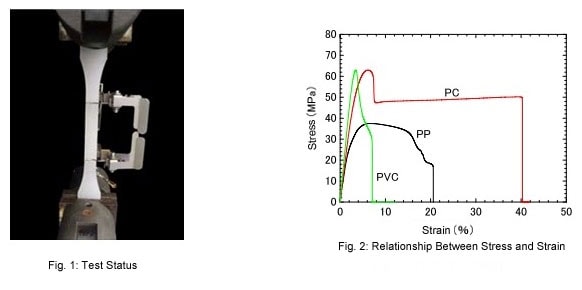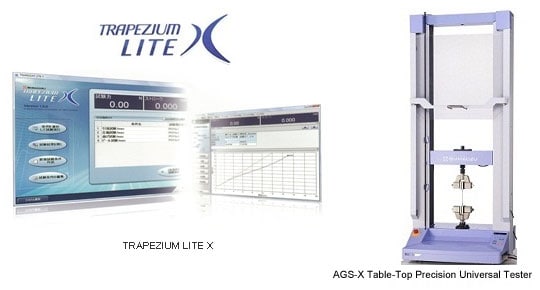All You Need To Know About Advanced Plastics Analysis
Tensile Test of Various Plastic Materials (2)
Tensile Test of Various Plastic Materials
【Standard No. ISO527-1:2012 (JIS K 7161: 1994)】
Introduction
Tensile tests are widely used to evaluate plastic materials, and the results are used as indices for new materials development and for implementing quality control. Items evaluated as tensile characteristics of plastic materials include the tensile modulus,strength, and break strain. In this Data, the tensile modulus of polypropylene (PP), polyvinyl chloride (PVC), and polycarbonate (PC) specimens (dumbbell shaped and cut types) was calculated based on displacement data acquired using an extensometer. The strength and break strain for the respective plastic materials are then determined from the test force values and crosshead travel distances detected with the tester.
Measurements and Jigs
To find a sample's tensile modulus, it is necessary to use an extensometer capable of measuring tiny deformations of the sample with high accuracy. Measurements of crosshead travel distances include errors not only from sample deformation, but also from load cell and test jig deformation. When the deformation region is very small, the ratio of the error becomes significant, so this data is not suitable for tensile modulus calculations. In such cases, an extensometer that can measure changes in the gauge length with an accuracy of at least ±1 % must be used. When measuring the modulus of elasticity with a 50 mm gauge length, this corresponds to an accuracy of ±1 μm. In this test, a strain gauge type one-touch extensometer that meets the above-mentioned conditions was used to measure elongation.
Measurement Results

Elongation was measured using the extensometer at a test speed of 1 mm/min within the elasticity region. After removing the extensometer, the test continued at a test speed of 50 mm/min until fracture of the specimen.

Plastic Material Tensile Test System
| Tester | AGS-X |
| Load Cell | 5 kN |
| Test Jig | 5 kN pneumatic flat grips (single-side file teeth grip faces) |
| Extensometer | Strain gauge type one-touch extensometer SSG50-10SH |
| External Amplifier | ESA-CU200 |
| Software | TRAPEZIUM LITE X |

- A high-precision load cell is adopted. (The high-precision type is class 0.5; the standard-precision type is class 1.)
Accuracy is guaranteed over a wide range, from 1/500 to 1/1 of the load cell capacity. This supports highly reliable test evaluations. - Crosshead speed range
Tests can be performed over a wide range from 0.001 mm/min to 1,000 mm/min. - High-speed sampling
High-speed sampling, as fast as 1 msec. - TRAPEZIUMX LITE X operational software
This is simple, highly effective software. - Jog controller (optional)
This allows hand-held control of the crosshead position. Fine position adjustment is possible using the jog dial. - Optional Test Devices
A variety of tests can be conducted by switching between an abundance of jigs in the lineup.


